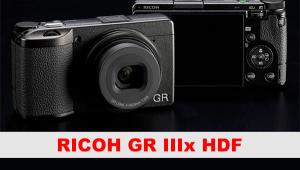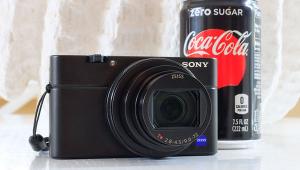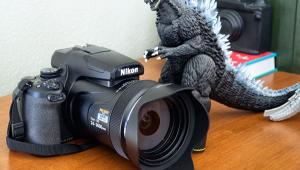High-Resolution Digicams; Do Major Megapixel Counts Aid Or Hinder Image Quality? Page 2
Pixel Size: D-SLRs Vs. Digicams
The image quality concerns refer primarily to ultrahigh-resolution digicams and not to D-SLRs. The latter employ comparatively oversized sensors with larger--and hence, more light sensitive--pixels. Such cameras should generate much cleaner data, producing less of a challenge for their processing engines at any ISO level. (Editor's Note: This is also the argument used by so-called "medium format" digital camera makers as to the superiority of their larger sensors vs. APS-C size sensors found in D-SLRs. Obviously that's a story for another day.)
 |
|
|
But just how small or large are the sensors employed by the latest cameras? That data is available in the specifications for some cameras, but requires a web search for certain other models. Our comparison chart lists the dimensions for the sensors most commonly used in high-resolution digicams and D-SLRs. Information on actual pixel size is rarely published. After extensive searching, I was able to find some data about pixel size in 8MP digicams, but not about the 12MP cameras.
Even so, the following information provides a practical glimpse at how a sensor's dimensions affect pixel size. My research revealed that the pixel size on an 8MP digicam's 1/1.7" type sensor is approximately 2.7x2.7 microns. (A micron is one thousandth of a millimeter.) That's miniscule when compared to the 6.4x6.4 micron size in an 8MP D-SLR with a 22.2x14.8mm sensor, for example. Obviously, we have even greater pixel size discrepancies when comparing a 12MP digicam (with the 1/1.7" sensor) to a D-SLR camera.
The chart below lists common sensors from small to large. All of the 12MP digicams that had been announced at the time of this writing employed the 7.6x5.7mm CCD but it's possible that some subsequent models may use other sensor sizes.
|
Comparison Chart
|
||
|
Sensor Type
|
Actual Dimensions
|
Comments
|
| 1/2.5" | 5.76x4.29mm | A very small sensor rarely used in digicams with 6MP or higher resolution. |
| 1/1.8" | 7.18x5.32mm | This sensor is used in some 8MP and 10MP although other models employ the 1/1.7" sensor. |
| 1/1.7" | 7.6x5.7mm | A slightly larger sensor that may become common in many (but perhaps not all) 12MP digicams. |
| 2/3" | 8.8x6.6mm | The largest sensor readily available for digicams but not in use at the time of this writing. |
| 4/3" CCD or new NMOS | 18x13.5mm | The sensor used in Olympus, Panasonic Lumix, and Leica D-SLRs. |
| Unique Foveon X3 sensor | 20.7x13.8mm | Available only in Sigma SD-series D-SLRs and in the new Sigma (14MP) DP1 digicam. |
| Canon APS-C format CMOS | Approximately 22.2x14.8mm | Canon's proprietary sensor used in most consumer-grade EOS cameras (except the EOS 5D). |
| APS-C format CCDs | Approximately 23.6x15.8mm | Various sensors of similar sizes, used in Fuji, Nikon, Pentax, and Sony D-SLRs. |
| Canon full-frame | 35.8x23.9mm | The 35mm film size sensor used in the EOS 5D and some pro EOS cameras. |
Resolution And Sharpening
Theoretically, 12 million vs. 10 million pixels should produce greater resolution. That may be true but it's not apparent in ISO 100 images viewed at high magnification on a monitor or in oversized prints. (Comparing a 12MP digicam to a 6MP D-SLR might be more revealing in this respect.) At a glance, fine detail seems to be sharper in the images made by one of the two digicams, but only because of a much stronger level of in camera sharpening at default. Setting the other cameras to a higher sharpening level negates that difference.
 |
|
 |
|
|
 |
|
 |
|
 |
|
 |
|
|
- Log in or register to post comments

















































